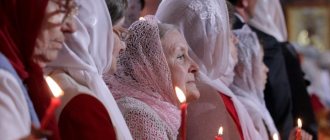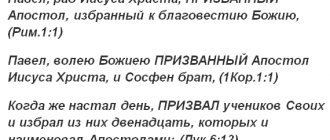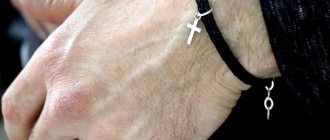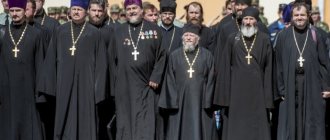Christian tradition requires representatives of the fair sex to appear in church with their heads covered. However, today this rule applies exclusively to Orthodox women in Russia. In Greece, ladies are allowed to enter the church without a headdress. Visitors to Orthodox forums are interested in whether believers in Russia need to wear a headscarf all the time? What do the holy fathers think about this? Is it permissible for an Orthodox woman to be outside the church without a headdress?
About the origins of the custom
In deep Christian antiquity, every respectable woman in Rus' was required to cover her head when leaving the house. The presence of a head veil, which, for example, can be seen on icons of the Mother of God, indicated that the woman was married and was in the power of her husband. A woman’s “bare crown” or loose, uncovered hair meant her humiliation or punishment.
Harlots and vicious women tended to demonstrate their belonging to a special profession by refusing to wear a headscarf. The husband was given the right to divorce his wife without returning her dowry if she was noticed on the street bare-haired: it was believed that the wife had insulted his honor by doing so. Unmarried girls and little girls were not supposed to wear a headscarf. Married women took off their hats at home. When going out into the street, they certainly covered their heads with a scarf.
A note for spicy food lovers: why mustard is harmful to health
The star of “The Last Hero” told how and with whom he spent the period of self-isolation
Never knock down the ice: how to save trees from return frosts
Men outside the home were not required to cover their heads. They could protect themselves from the heat with a hat, and even then at their own request, and without obeying any rules.
Islam
The principles of the Muslim religion are more radical. In Islam, awrah (concealment of nudity) is strictly observed. According to the Koran, a Muslim woman must sacredly honor God's advice and be pure. In Islam, it is prescribed for a woman to cover her entire body, including her feet and hands, while part of her face may remain uncovered. There is no specific clause about covering the head in the scripture, but the clause “hiding the whole body” also includes the head. There is a tradition that in Islam came from the Prophet Muhammad. All his children were girls. And he asked them and their wives to wear headscarves so that everyone around them would know that these women were from his family. In modern Islam this tradition is sacredly revered.
What did the Apostle Paul say about this custom?
The Apostle Paul believed that during divine services women must have their heads covered:
I also want you to know that the head of every husband is Christ, the head of every wife is her husband, and the head of Christ is God. Every man who prays or prophesies with his head covered disgraces his head. And every woman who prays or prophesies with her head uncovered disgraces her head, for it is the same as if she were shaved. For if the wife does not want to cover herself, then let her cut her hair; and if a wife is ashamed to be shorn or shaved, let her cover herself. So a husband should not cover his head, because he is the image and glory of God; and the wife is the glory of the husband. For man is not from wife, but woman is from man; and man was not created for wife, but woman for man. Therefore, a wife should have on her head a sign of power over her, for the Angels.
How to achieve a natural result when highlighting your hair: 5 best ways
You can also have sweets: a nutritionist said that it’s not harmful to eat sweets in the morning
“It’s really expensive”: Vasilisa Volodina announced the cost of an hour of her consultation
What the saint thought about how women should act outside the temple - whether to wear hats or not - nothing is known to history.
So should a woman cover her head during prayer (in church or outside of it)
How does the passage apply today? I can't believe that there is a commandment about hair length in 1 Corinthians 11. Although many women will choose to wear longer hairstyles, in light of this passage. Paul's specific advice to the people of that culture should not be taken as a prescription for modern hairdressers. Or our women will also have to wear a veil (or cover). Let's think about the principle. All life passes in submission to the power of God and those above us. Cultural details about coverings and hairstyles of the first century do not apply to the 21st century. Decide for yourself how you will apply the principle of submission to God and Christ, and if you are a woman, then to your husband.
There are no Christian regulations regarding the design of beards and sideburns, as far as I know. There may be references to the prescriptions established by the Old Testament, but we, as Christians, do not consider them. One way or another, let's try to get to the heart and meaning of what Paul was trying to convey to us in 1 Corinthians 11, looking beyond the strict limits of keeping the law.
What do modern priests think about this?
Priest Maxim Kaskun believes that an Orthodox woman should wear a headscarf at all times:
Married women must wear a headscarf; girls can do without it, as was the case in ancient times. Then all women, even little girls, began to wear headscarves; it’s right that they get used to it from childhood. Today, many are embarrassed by the headscarf, because the headscarf is the power of a husband over a woman. Today women are raised feminist and subconsciously resist this sign. By wearing a headscarf, a woman shows that she is a married woman, and accordingly, it is an honor for her.
A cup of coffee, a walk to work: changes in daily routine reduce the risk of dementia
We remove all things from the car: safe methods of parking with protection against burglary
Eastern beauty: 4 spouses of Ravshana Kurkova, whom she sincerely loved
Father believes that if it is hot or some other circumstances force you to do so, you can walk without a headscarf. Father Maxim adds:
If a woman does housework, then the scarf has a practical purpose. Do not be embarrassed, wear a headscarf for the Glory of God, because it is right.
Priest Maxim Andreev also believes that Orthodox Christian women absolutely need to wear a headscarf in everyday life. The Holy Father gives the same arguments:
Regarding married women: during the wedding, the priest blesses them with a warrior and places it on their head. The covered head symbolizes that she is married, has fidelity to her husband, obeys and belongs to him, thereby obeying God.
The Holy Father, like his other colleagues, believes that if a married woman walks around with her head uncovered (with bare hair), this indicates her depravity, that is, behavior that is unworthy of an Orthodox Christian woman. A girl has the right to walk outside the temple without a headscarf. In ancient times, the Holy Father reminds, girls were even allowed to take communion without a headscarf (like Christ’s brides).
“Don’t tear, don’t disband, don’t kill yourself”
After Russia adopted Orthodoxy, pagan beliefs were preserved among the people for some time. However, already in the 15th century such behavior at funerals was rare. There is, however, evidence that there was a lot of crying at Christian funerals. When Ivan the Terrible’s brother, Prince Yuri Vasilyevich Uglichsky, died, according to the Moscow Chronicle, the boyars and princely relatives, as well as the Orthodox, “shed many tears and created great cries.” However, the chroniclers explained such behavior of Christians not even by tradition, but by the grief that could await the townspeople after the death of the ruler.
We advise you to study What to do with old icons from home
In the 16th century, an unknown English traveler described crying at funerals as the norm. According to him, the relatives of the deceased carried the deceased to the temple, holding lit candles, and everyone cried, sobbed a lot and wailed. However, no one let down their hair, tore their clothes, and certainly did not injure themselves.
But why did some expressions of grief remain in the past, while others were allowed?
It turns out that the Orthodox Church made a significant contribution to this, which directly fought and prohibited the manifestation of pagan demons at funerals.
Historian Elena Borisovna Gruznova in her article “Funeral customs in Rus' at the end of the 15th – 16th centuries.” indicates that the priests, even during confession, could ask the question: was the woman worried too much about the deceased? This was considered a sin because it went against faith in Christ and in eternal life that awaits the righteous beyond the grave. If God has everyone alive, then there is no point in prolonged grief, because we will all meet again sooner or later.
Paganism considered death the loss of all earthly blessings - this was clearly expressed in lamentations over the deceased.
The texts of John Zlotoust's sermons, distributed in Rus' in the 15th century, directly indicated the prohibition of behaving promiscuously during a funeral, screaming, scratching and letting down one's hair. In the breviaries of that time, priests were asked to ask the laity the following questions during confession: “Or did you weep without measure for the dead and torment your hair?”, “Or did you cut the hair on your head?”
How important is this question?
Many believers consider this issue a frivolous topic for discussion. “Why even pay attention to such little things?” - forum visitors ask. However, psychologists believe that a person’s appearance significantly influences his mood, sense of self, character and behavior.
From a psychological point of view, a headscarf is a sign of modesty and fidelity - the most important distinguishing qualities of a true Christian. By choosing a headscarf out of obedience to God, believing women strengthen their devotion to God. According to the Apostle Paul, representatives of the fair sex should have their heads covered when they pray. The Holy Fathers remind modern Christians that it is necessary to pray constantly, not only during divine services. There is only one conclusion: an Orthodox woman should always wear a headdress.
Found a violation? Report content
Trousers as a masculine element
Is it possible for a woman to wear trousers to church? Now few, besides historians, will be able to remember that wearing this item of clothing when visiting church was previously strictly prohibited even for men. In the 9th century, the Bulgarian prince almost refused to baptize the country due to the fact that the Byzantine superiors demanded that his subordinates be prohibited from wearing trousers even outside the walls of the temple. This form of clothing was called pagan. In later times, no one saw anything in trousers that did not correspond to the Christian faith, and until modern times, women never wore trousers. Thus, trousers were only a male attribute.










